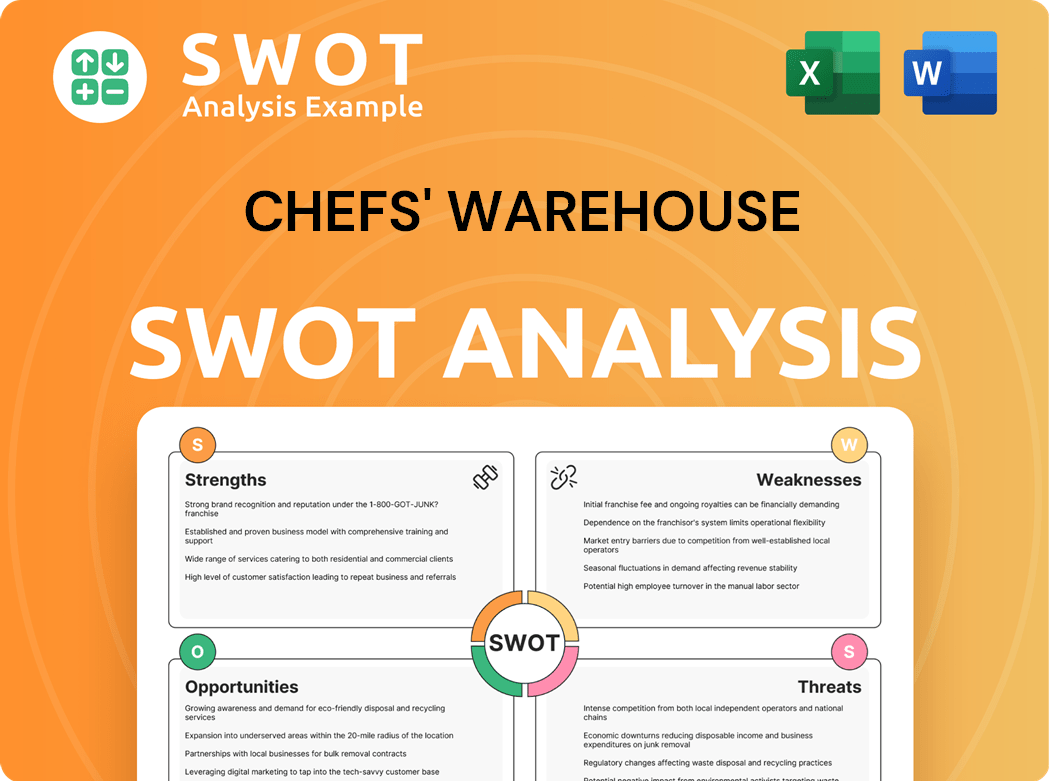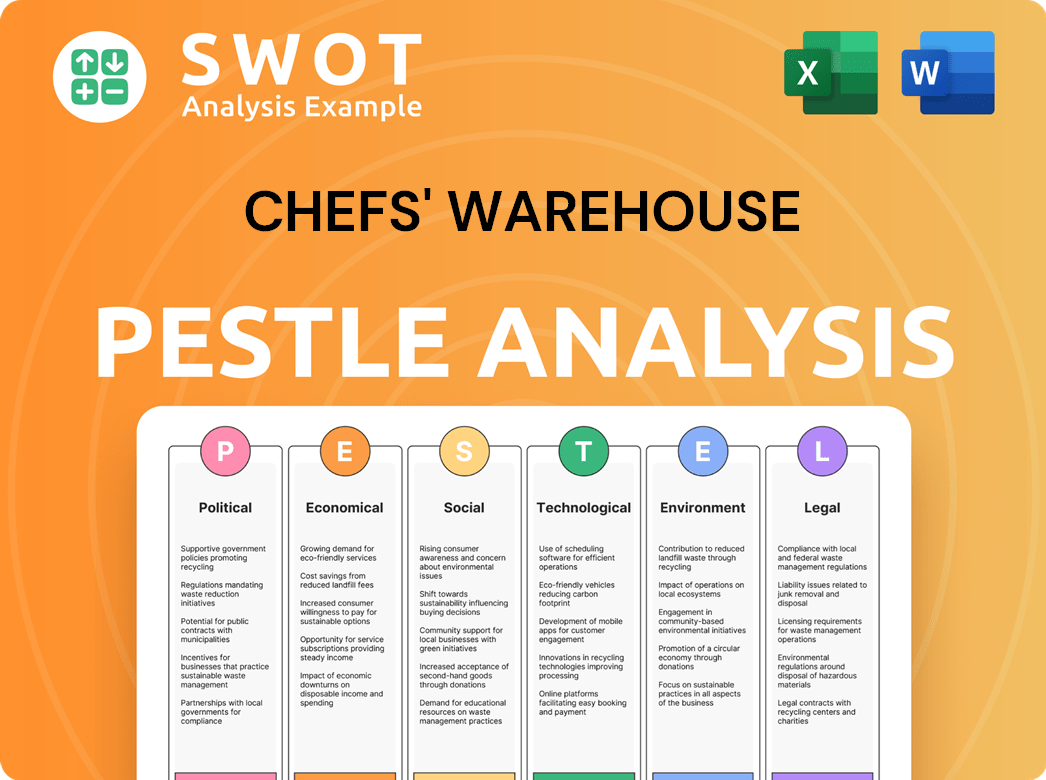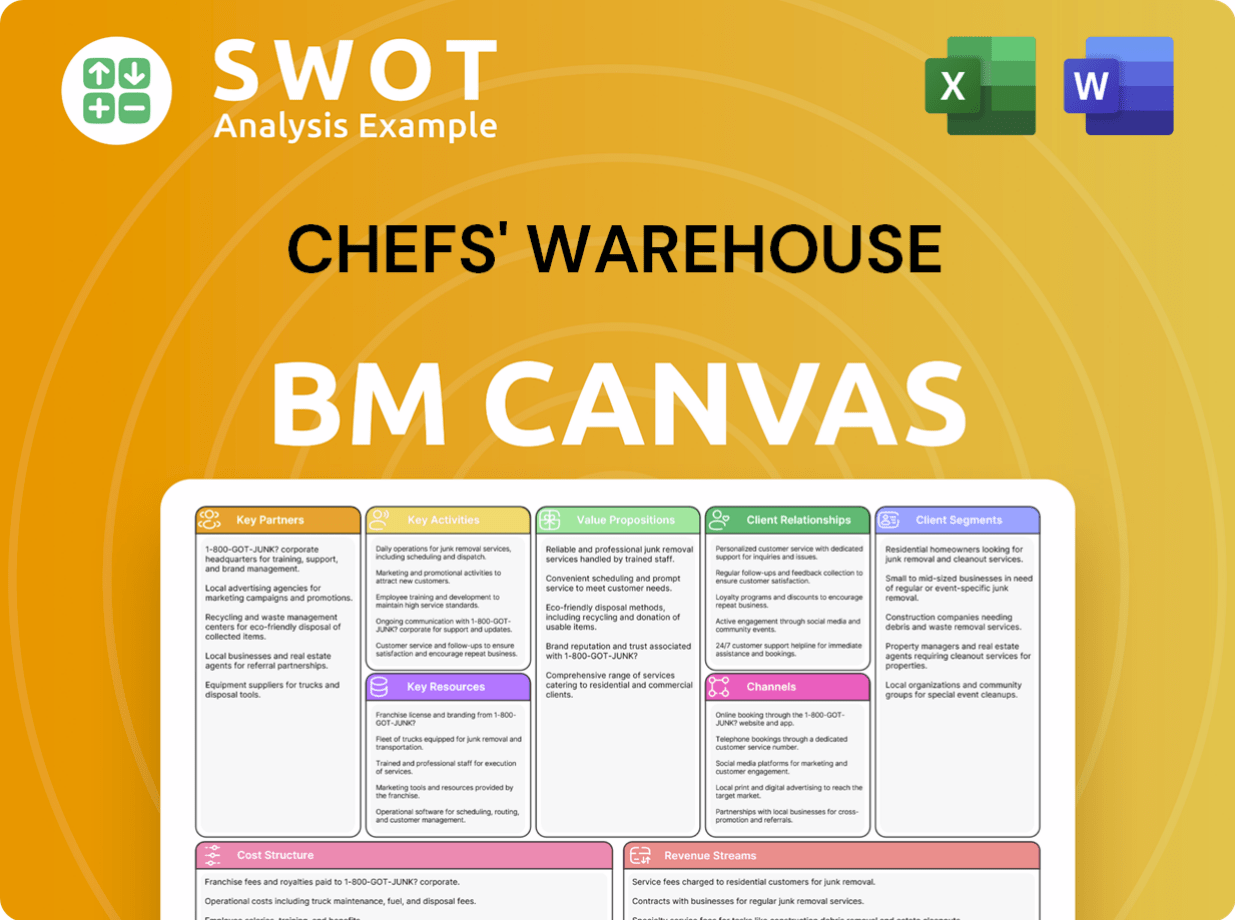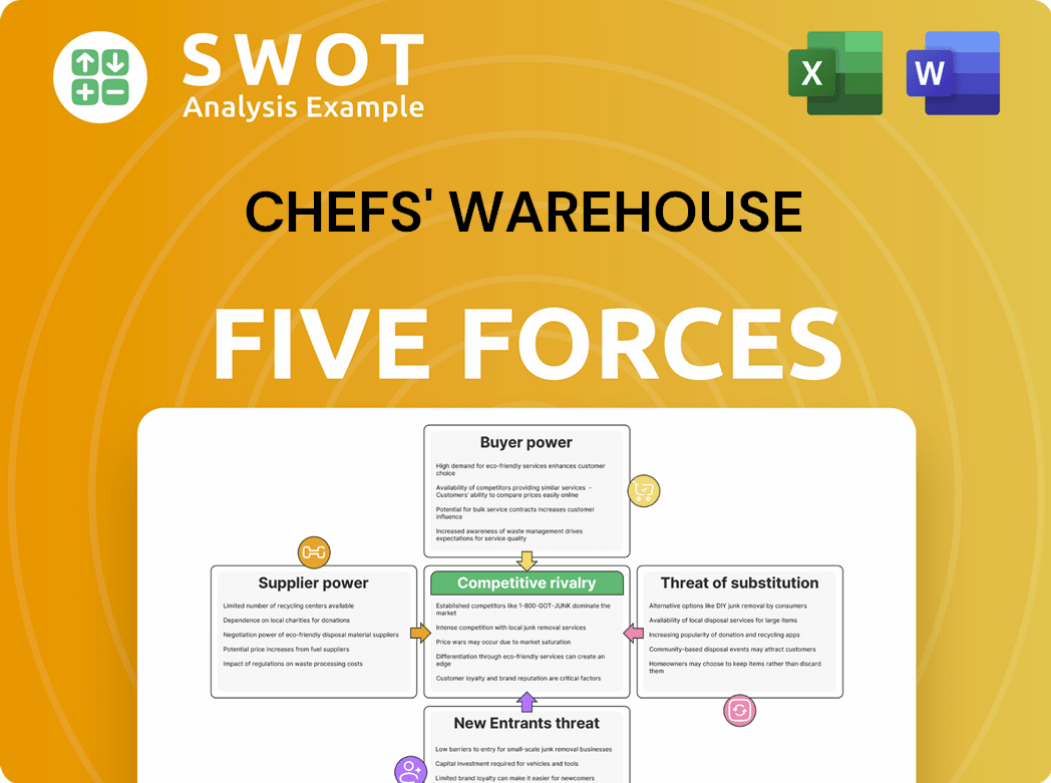Chefs' Warehouse Bundle
Can Chefs' Warehouse Continue to Sizzle in the Specialty Food Market?
The specialty food distribution sector is a dynamic arena, and The Chefs' Warehouse (CHEF) has carved a significant niche for itself. From its roots as a small supplier, the company has expanded to become a major player, serving a vast network of high-end restaurants and culinary establishments. This article explores the Chefs' Warehouse SWOT Analysis, its growth strategy, and what the future holds for this key player in the food distribution industry.

The Chefs' Warehouse's journey offers a compelling case study in strategic growth and market adaptation. With its focus on specialty food and restaurant suppliers, the company has consistently aimed to expand its distribution network and product offerings. This analysis will examine the company's financial performance, expansion plans, and competitive landscape to provide a comprehensive view of its future outlook and potential for continued revenue growth in the competitive food distribution market.
How Is Chefs' Warehouse Expanding Its Reach?
The Chefs' Warehouse is actively pursuing several expansion initiatives to strengthen its market presence and diversify its revenue streams. This growth strategy includes strategic acquisitions, infrastructure investments, and expansion into new product categories. These efforts are designed to increase market share, broaden its customer base, and enhance its overall financial performance.
A core component of the company's strategy involves strategic acquisitions. These acquisitions have historically expanded the company's distribution capabilities and customer base. The company aims to increase its share of the customer wallet by expanding into new categories, like produce, to increase its market share within existing markets by cultivating new customer relationships among independent restaurants, hotels, country clubs, and other culinary establishments.
The company's strategic approach is also supported by investments in its infrastructure to expand its distribution capacity and geographic penetration. These investments are crucial for supporting the company's growth trajectory and enhancing its ability to serve its expanding customer base effectively. For a deeper understanding of the competitive environment, consider exploring the Competitors Landscape of Chefs' Warehouse.
In fiscal year 2024, the company acquired GreenLeaf and Hardie's Fresh Foods. These acquisitions significantly enhanced its specialty produce distribution in Northern California and Texas. These acquisitions enable The Chefs' Warehouse to leverage existing products in new markets and broaden its customer reach.
As of December 27, 2024, the company's distribution capacity grew to approximately 3.0 million square feet across 49 facilities. Recent expansions include new distribution centers in Portland, San Francisco, United Arab Emirates, Philadelphia, Los Angeles, and Miami.
In 2024, the company completed a new center-of-the-plate processing and distribution facility in Richmond, California, consolidating four existing facilities, and expanded its specialty distribution center in Dubai, UAE, which now includes a culinary test kitchen and training center.
The company plans to continue investing in sales and service territory expansion, aiming to increase its market share within existing markets by cultivating new customer relationships among independent restaurants, hotels, country clubs, and other culinary establishments.
The Chefs' Warehouse has a history of strategic acquisitions and infrastructure investments. These initiatives are designed to support the company's growth strategy and enhance its market position within the food distribution sector. The company's focus on expanding its distribution network and product offerings is a key part of its future outlook.
- Completed acquisitions of GreenLeaf and Hardie's Fresh Foods in 2024.
- Increased distribution capacity to approximately 3.0 million square feet.
- Expanded distribution centers in multiple strategic locations.
- Continued investment in sales and service territory expansion.
Chefs' Warehouse SWOT Analysis
- Complete SWOT Breakdown
- Fully Customizable
- Editable in Excel & Word
- Professional Formatting
- Investor-Ready Format

How Does Chefs' Warehouse Invest in Innovation?
The Chefs' Warehouse is actively leveraging innovation and technology to drive its growth strategy and enhance operational efficiency within the food distribution sector. This includes a strong focus on digital platforms and improvements in its operational infrastructure. The company's strategic investments aim to increase market share and expand its geographic reach, particularly in the specialty food market.
A key aspect of the company's strategy is the continued adoption of its digital platform, which is enhancing customer engagement. The company is also investing in new distribution centers and proprietary brands to broaden geographic penetration. These initiatives are designed to improve efficiency, reduce costs, and appeal to environmentally conscious customers, contributing to the overall Chefs' Warehouse prospects.
The company's approach to technology and sustainability is multifaceted, encompassing digital platforms, operational infrastructure, and environmental initiatives. These efforts highlight the company's commitment to adapting to evolving market demands and strengthening its position in the competitive landscape.
In 2024, 56% of domestic specialty customers ordered online. By Q1 2025, this figure increased to 58%, reflecting the success of digital adoption in enhancing customer engagement. This growth indicates a strong shift towards digital ordering within the customer base.
The company is investing in new distribution centers and proprietary brands. These investments are designed to broaden geographic penetration and increase market share. This expansion strategy is crucial for long-term growth.
While cautious about full-scale supply chain automation, the company favors incremental improvements. This approach allows for quicker returns on investment. The focus is on practical and efficient upgrades.
The company is actively testing zero-emission vehicles in West Coast facilities. Plans include converting a significant portion of the California fleet to clean energy by 2026, aiming for up to 10%. Investments in renewable energy sources, such as solar panel installations, are also underway.
A 617 kWp solar panel system is being finalized for the Middle East branch. This investment highlights the company's commitment to sustainable operations. These efforts are part of a broader strategy.
The company is expanding its digital platforms in the Middle East and Hardie's operations. This expansion is part of the overall growth strategy. This is a key component of the company's future outlook.
These technology and innovation initiatives are integral to the company's growth strategy. The company's focus on digital platforms, operational improvements, and sustainability initiatives reflects a commitment to meeting customer needs and enhancing operational efficiency. The company's approach to sustainability and technological advancements contributes to its growth objectives by improving efficiency, reducing costs, and appealing to environmentally conscious customers. The company's commitment to innovation and technology is further detailed in Mission, Vision & Core Values of Chefs' Warehouse.
The Chefs' Warehouse is focusing on several key areas to drive growth and improve efficiency. These strategies are designed to enhance the company's competitive position and ensure long-term success. This includes:
- Continued investment in digital platforms to enhance customer engagement and streamline ordering processes.
- Strategic investments in new distribution centers and proprietary brands to broaden geographic penetration and increase market share.
- Incremental improvements in supply chain management, focusing on efficiency gains and quicker returns on investment.
- Testing and implementation of zero-emission vehicles and renewable energy sources to reduce environmental impact and appeal to eco-conscious customers.
- Expansion of digital platforms in new markets, such as the Middle East, to capitalize on growth opportunities.
Chefs' Warehouse PESTLE Analysis
- Covers All 6 PESTLE Categories
- No Research Needed – Save Hours of Work
- Built by Experts, Trusted by Consultants
- Instant Download, Ready to Use
- 100% Editable, Fully Customizable

What Is Chefs' Warehouse’s Growth Forecast?
The financial outlook for The Chefs' Warehouse indicates continued growth, with promising projections for fiscal year 2025. The company's strategic focus on the food distribution sector, coupled with its strong performance in recent years, positions it well for future expansion. The company's ability to navigate market dynamics and capitalize on opportunities within the specialty food and restaurant suppliers segments is crucial for its growth strategy.
The company's financial performance in 2024 demonstrates its resilience and ability to generate strong revenue growth. The positive trends in revenue and profitability, including the achievement of $1 billion in quarterly revenue, highlight the company's operational efficiency and market strength. The company's focus on strategic initiatives, such as supply chain management, is essential for maintaining its competitive edge.
The company has a well-defined growth strategy, which includes expansion plans and potential acquisitions. These initiatives are expected to contribute to the company's continued success in the specialty food market. Analyzing the Brief History of Chefs' Warehouse provides insights into its evolution and strategic decisions.
For fiscal year 2025, The Chefs' Warehouse anticipates net sales between $3.94 billion and $4.04 billion. Gross profit is expected to range from $951 million to $976 million. Adjusted EBITDA is forecasted to be between $233 million and $246 million.
Analysts estimate that the company's earnings should grow by 20% annually over the next three years. This growth rate is significantly higher than the 11% per year growth forecast for the broader market.
Total revenue for fiscal 2024 increased by approximately 11% to about $3.8 billion. This growth reflects the company's strong market position and efficient operations within the food distribution sector. The company's revenue growth is a key indicator of its financial health.
Adjusted EBITDA for fiscal year 2024 was approximately $219 million. This figure highlights the company's profitability and its ability to manage operating expenses effectively. The company's EBITDA margin is a key metric for investors.
In Q4 2024, net sales increased by 8.7% to $1,033.6 million, marking the first time the company achieved $1 billion in quarterly revenue. Gross profit increased by 9.8% to $251.0 million, with gross profit margins increasing by approximately 23 basis points to 24.3%.
- This performance demonstrates the company's strong sales growth.
- The increase in gross profit margins indicates improved operational efficiency.
- The achievement of $1 billion in revenue in a single quarter is a significant milestone.
- The company's ability to maintain and improve profitability is evident.
In Q1 2025, net sales increased by 8.7% to $950.7 million. GAAP net income rose significantly to $10.3 million, up from $1.9 million in Q1 2024. Adjusted EBITDA reached $47.5 million, compared to $40.2 million in Q1 2024.
- The increase in net sales reflects continued revenue growth.
- The significant rise in GAAP net income indicates improved profitability.
- The growth in Adjusted EBITDA demonstrates the company's operational efficiency.
- These results underscore the company's strong financial performance.
The company generated approximately $104 million of free cash flow in 2024. The company repurchased about $17 million in common shares under its approved $100 million share repurchase program. Capital expenditures for fiscal 2025 are expected to be approximately $40 million to $50 million, excluding cash paid for acquisitions.
- The strong free cash flow generation supports the company's financial flexibility.
- The share repurchase program reflects the company's commitment to shareholder value.
- Capital expenditures are focused on reducing operating expenses.
- These financial strategies contribute to the company's long-term growth.
Chefs' Warehouse Business Model Canvas
- Complete 9-Block Business Model Canvas
- Effortlessly Communicate Your Business Strategy
- Investor-Ready BMC Format
- 100% Editable and Customizable
- Clear and Structured Layout

What Risks Could Slow Chefs' Warehouse’s Growth?
The future of Chefs' Warehouse, while promising, is subject to various risks and obstacles. The company operates within the competitive food distribution sector, which can pressure profit margins. Economic downturns and shifts in consumer behavior, such as reduced restaurant dining, could also negatively affect demand for their products.
Inflationary pressures, particularly in ingredients like chocolate and eggs, and rising expenses in distribution, packaging, and labor, pose challenges to profitability. Supply chain disruptions and vulnerabilities represent ongoing risks that could lead to increased costs and product shortages. Regulatory changes, including food safety regulations and import/export tariffs, also present additional hurdles.
Technological advancements and the ability to adapt quickly are crucial. Internal resource constraints and the effective management of growth, especially through rapid expansion and acquisitions, are also significant factors. The company's strategies include diversifying its customer base and focusing on cost control.
The specialty food distribution industry is highly competitive, potentially impacting the company's market share and profit margins. The company addresses this by focusing on value-added services and customer loyalty programs.
Economic downturns and changes in consumer spending, such as decreased restaurant visits, could decrease demand for products. This could affect the company's revenue and overall financial performance.
Inflationary pressures, especially in key ingredients and operational expenses such as distribution, packaging, and labor, can erode profitability. The company needs to manage these costs effectively to maintain margins.
Supply chain vulnerabilities and potential disruptions can lead to increased costs and product shortages. The company mitigates this by developing multiple supplier relationships to ensure a stable supply.
Changes in food safety regulations and import/export tariffs can create additional risks. Food import tariffs can range between 5.5% and 37.5% depending on the product category, potentially increasing costs.
Failure to quickly adapt to technological advancements could pose a risk. The company needs to invest in technology to improve efficiency and stay competitive.
To address these risks, the company employs various strategies. These include diversifying its customer base, implementing cost control measures, and continuing to invest in operational efficiencies and technology. These actions are designed to improve Chefs' Warehouse's financial performance.
The company maintains a diversified supply chain and relies on domestic producers to reduce tariff risks. They also emphasize their strong suburban restaurant business and diverse customer base to withstand potential tourism slowdowns, which is a key part of their growth strategy.
Chefs' Warehouse Porter's Five Forces Analysis
- Covers All 5 Competitive Forces in Detail
- Structured for Consultants, Students, and Founders
- 100% Editable in Microsoft Word & Excel
- Instant Digital Download – Use Immediately
- Compatible with Mac & PC – Fully Unlocked

Related Blogs
- What are Mission Vision & Core Values of Chefs' Warehouse Company?
- What is Competitive Landscape of Chefs' Warehouse Company?
- How Does Chefs' Warehouse Company Work?
- What is Sales and Marketing Strategy of Chefs' Warehouse Company?
- What is Brief History of Chefs' Warehouse Company?
- Who Owns Chefs' Warehouse Company?
- What is Customer Demographics and Target Market of Chefs' Warehouse Company?
Disclaimer
All information, articles, and product details provided on this website are for general informational and educational purposes only. We do not claim any ownership over, nor do we intend to infringe upon, any trademarks, copyrights, logos, brand names, or other intellectual property mentioned or depicted on this site. Such intellectual property remains the property of its respective owners, and any references here are made solely for identification or informational purposes, without implying any affiliation, endorsement, or partnership.
We make no representations or warranties, express or implied, regarding the accuracy, completeness, or suitability of any content or products presented. Nothing on this website should be construed as legal, tax, investment, financial, medical, or other professional advice. In addition, no part of this site—including articles or product references—constitutes a solicitation, recommendation, endorsement, advertisement, or offer to buy or sell any securities, franchises, or other financial instruments, particularly in jurisdictions where such activity would be unlawful.
All content is of a general nature and may not address the specific circumstances of any individual or entity. It is not a substitute for professional advice or services. Any actions you take based on the information provided here are strictly at your own risk. You accept full responsibility for any decisions or outcomes arising from your use of this website and agree to release us from any liability in connection with your use of, or reliance upon, the content or products found herein.